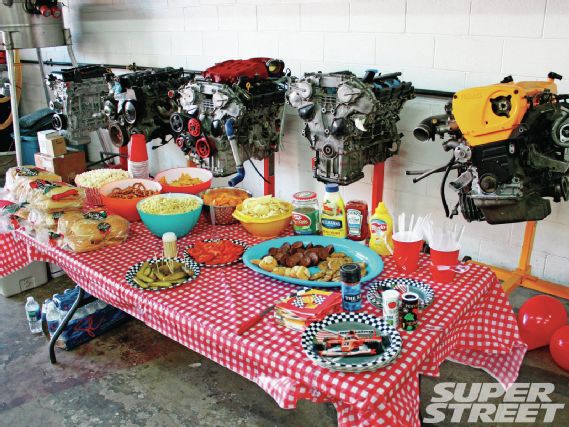 | What does junk food have to do with building power? Absolutely nothing! Bon appetit!.
| What does junk food have to do with building power? Absolutely nothing! Bon appetit!.
There are a number of us Nissan fanatics out there, myself being one of them. I can vividly remember being fifteen years young in my parent’s garage getting my first SR20 swap to run. The car was so rotted it couldn’t be jacked up without endangering anyone’s life, but I loved it.
Nissan has graced us with a collection of great engines, many of which can reliably handle a ton of horsepower on boost without any internal work. This article will give you an idea of how to go about modifying Nissan’s most popular performance engines; the SR20DET, RB-series, VQ35DE and VR38DETT.
VQ35DE
The VQ is more complicated to extract power from than the rest of the engines in this article, simply because it’s naturally-aspirated. Before spending any money on the VQ, you need to decide whether you want to stay NA, go supercharged or turbocharged. I’ve done a fair bit of work for each option, and it really comes down to how much power you want in the end, what kind of driving you do with the car, and what your budget is. The VQ has changed over the years as well, with standard, rev-up and HR variants.
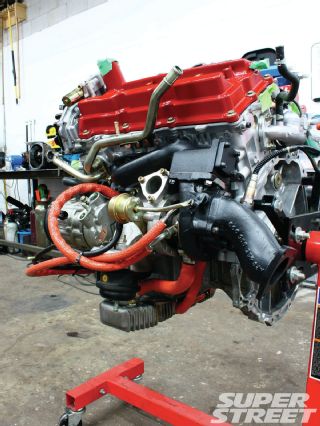 |
Building Power With Nissan’s Most Popular Engines - Tech
|
Building Power With Nissan’s Most Popular Engines - Tech
OVERVIEW
I always suggest taking the supercharged route with the VQ. Unless you have a huge budget and are planning on building the engine, almost all turbo kits create enough power to throw a rod and blow the engine up right out of the box. The standard and rev-up engines are known to throw rods right around 400whp. Superchargers tend to create less torque than turbo kits, which can extend engine life. A supercharger has another advantage in that they produce less heat. The VQ is a wide engine. Strapping two turbos to it, or one single with a plethora of piping creates a ton of heat, and it’s been my experience that engine cooling becomes difficult. Superchargers are also more responsive, which in my opinion, makes them more fun to drive.
If you can live with a car that is moderately fast, some naturally-aspirated modifications can make the car quick, fun to drive and 100% reliable. This is the direction I point people in if they are planning on going to the racetrack with their cars, as power is really the last piece of the puzzle when talking about road racing.
ENTRY-LEVEL TUNING
If you want to stick with NA, your modification list should look something like this. It will net you around 280-300whp and be about the same price as the supercharged route below. A little less power, but a lot of reliability and an incredible sound:
• Camshafts: Large, aggressive cams. This engine needs cams to make power. Period.
• Valvetrain: Aftermarket valve springs matched to the cams.
• Exhaust: Long-tube headers designed with true merge collectors and a high-flowing exhaust.
• Engine management: ECU flash, dyno tuned to optimize cam and ignition timing.
• Intake: A properly designed aftermarket intake, preferably mated to a ported throttle body and a manifold plenum spacer.
AGGRESSIVE TUNING
The VQ has two major hurdles that occur right around 400-450whp. Number one, the engine is going to throw a rod—that much is certain. That hurdle requires a built block, which is going to cost you $7,000 on the cheap side if you don’t do the labor yourself. The second hurdle is the factory returnless fuel system. This is great for simplicity, but it’s not good for performance. A return fuel system is expensive, but necessary. For those reasons, the best bang for your buck really comes at 350whp with the stock engine and fuel system. A 350whp supercharged system would look something like this:
• Supercharger “tuner” kit: Any kit with a front-mount intercooler that you desire—just don’t buy into the gimmicky fuel solutions that are often offered.
• Larger fuel pump: modifications to the factory pump assembly will be required to work with the higher output fuel pump.
• Larger fuel injectors: up to a maximum of 740cc.
• MAF: Higher capacity MAF sensor element.
• Engine management: custom re-flash tuning for the new injectors and MAF will be required. This is the correct solution for the engine as the factory ECU is still controlling the system, rather than being tricked by other electronics.
• Exhaust: Aftermarket cat-back exhaust system.
• Spark plugs: One-step colder spark plugs to reduce the likelihood of detonation.
• Aftermarket clutch and flywheel: the stock flywheel is a dual mass unit and makes the car incredibly boring to drive. Get rid of it.
GETTING CRAZY
With the VQ you have two options if you have an inordinate amount of money. Number one: retarded power. Number two: NA glory. Each option requires vastly different parts from one another, and once you pick a path there’s really no turning back.
Retarded power calls for a twin-turbo kit. Throw out the turbos supplied with the kit and go even bigger, with external wastegates. A return fuel system with dual pumps will be required, along with big fuel injectors and a plug and play standalone ECU. The engine will need to be built with pistons, rods, mild cams and larger, stronger head studs. This setup should make anywhere from 600-900whp depending on how you size the turbos. Naturally, you’ll need the cooling modifications to support the setup, and you’ll find you spend a lot of money on oil coolers, ducting and plumbing to get the setup reliable.
If you’re looking for NA glory, you can pretty much throw out the idea of ever driving the car on the street again. Everything that makes power at 9000rpm also makes the car try to kill itself at idle and surge and buck below 3000rpm. When it comes to NA, friction is the enemy and airflow is king. Keep airflow up at high RPM while keeping friction low, and you’ll make gobs of power. The VQ has beautiful heads, and they can handle extreme RPM without concern.
The oil pump and block are the main concerns for RPM. Higher compression pistons are needed with big cams, but putting those two things together with variable valve timing means piston to valve clearance may become less than zero. For that reason, you may need to limit cam travel and/or have custom pistons machined with deeper valve reliefs. Head porting is very important for airflow, as is matching your cam selection to a properly-tuned custom race header. Just be prepared to never make it above 400whp, but to have one of the best sounding engines out there.
CONCLUSION
The VQ is so close to being the perfect engine that it’s saddening. The two major hurdles that stop us from making big power could be easily resolved at the factory with slightly stronger rods and a return style fuel system. I guess that’s why they saved them for the GT-R instead.
The VQ is a high compression naturally-aspirated engine, and we can’t forget that. It was never designed for forced induction, and so to feed it boost reliably, you really need to spend some money. For that reason, we’re respecting its limits, enjoying 100whp per liter and instantaneous engine response with a supercharger, and leaving it at that. Or, perhaps, even better, just leave it NA—bolt on some cams, headers, tune it and enjoy. These cars are still fun to drive with that kind of power, and with the money you save, you can set the rest of the car up to be really fast on the track.
Strengths Weaknesses
- 3.5L of displacement makes a lot of torque NA, which makes a responsive, fun to drive car.
- Beautiful head design that encourages high rpm with shimlesscam-on-bucket lifters.
- Variable cam timing adds mid-range power and spools turbos very quickly.
- Great gearbox that can handle a ton of power.
- Huge availability of aftermarket parts.
- Weak block that can only handle ~400whp.
- High compression, not designed for forced induction.
- DOHC V6 is fairly heavy compared to an inline-4.
- Returnless fuel system is limited to roughly 450whp.
- Extremely complicated factory engine management with cam control.and throttle-by-wire means there are limited ECU options.
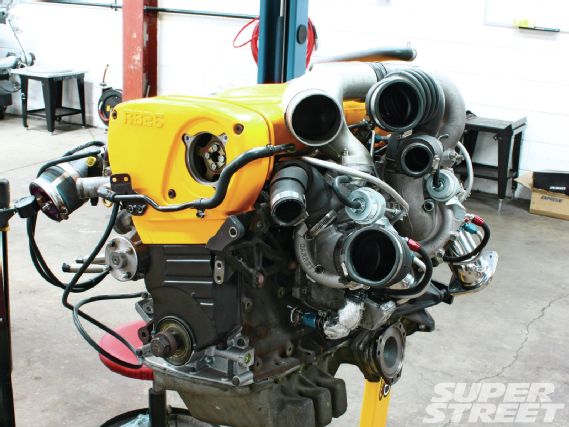 | Building Power With Nissan’s Most Popular Engines - Tech
| Building Power With Nissan’s Most Popular Engines - Tech
RB-Series
The RB engine is possibly one of the best sounding engines Nissan has ever made. Its short stroke and small bore give it a smooth, exotic sound that is pure bliss to the ears. Nissan originally designed the RB26DETT for their GT-R supercar in the late 80’s, and at that time it seemed like Nissan’s engineers were trying every trick in the book to make power, which makes the engine great, but also very complicated. The RB25DET is the simpler single-turbo variant of the same block, and while it tends to be less complex, it requires more work than the RB26 to make the same power.
OVERVIEW
While being a great engine, the RB does have some downfalls. The stock twin-turbo system on the RB26, along with the vacuum, water and oil plumbing is fairly complicated and cracked hoses can cause lots of problems that can be a pain to track down. Also, you need to keep in mind that the RB26 comes with an AWD transmission, which either needs to be modified or replaced and adds an additional cost to the swap when compared to the RB25, which has a RWD gearbox.
The first step when working on an RB, especially in a swapped car, is to simplify it as much as possible. Remove all of the unnecessary plumbing from the engine and replace all the old hoses with new ones. The engine is pretty close to bulletproof and she’ll handle 500whp without a hiccup. The RB25 usually works best with an aftermarket intake manifold that eliminates the crossover style plenum, making the intercooler piping more similar to an RB26. Both engines will need a turbo upgrade to make substantial power over stock, but otherwise the engine doesn’t need much.
ENTRY-LEVEL TUNING
When it comes to the RB, your best value is right around 400-450whp. The RB26 is more expensive initially, but the RB25 (in my mind) requires an aftermarket intake manifold, exhaust manifold and external wastegate to be a really clean, efficient package. Much more than 450-500whp and the RB turns laggy and some major fuel system modifications would be required. Here’s a good 400-450whp formula:
• (RB26) Upgraded turbos: Garrett, HKS and Tomei make drop-in replacements. The factory ceramic wheel turbos cannot handle high boost. You can size turbos for anywhere from 480 to 700whp, although for response and “fun to drive” factor I would stick with a conservative power goal (500whp is still RETARDED FAST) and enjoy the quicker spool and mid-range power.
• (RB25) Aftermarket exhaust manifold, single turbo and external wastegate: A little more expensive than retaining the factory manifold, but the performance gain is well worth it as the factory RB25 manifold is restrictive. As I always suggest, you need to size your turbo for response. A Garrett 3071 or 3076 would be incredibly fun to drive, even if it “only” makes 400-450whp.
• Larger fuel injectors: More power requires more fuel.
• Larger fuel pump: There are drop-in replacements ready to handle the additional requirements of a modified RB.
• Engine management: Some type of fuel management system with professional tuning on a dyno will yield the largest gains.
• Free-flowing intake and exhaust: backpressure creates heat, slows turbo response and kills power. Restrictive intakes cause an increase in charge temperature and turbo lag.
• Front-mount intercooler: Required for big power. Size the core based on the power you want to make to reduce turbo lag.
• Aftermarket clutch: The stock one will last for a little while, but in the long run it will need to be upgraded. Aftermarket flywheels make the inline-6 rev so much quicker.
• Aftermarket or really-fresh OEM coilpacks: old RB coilpacks don’t have the energy to fire a spark under high rpm and high boost and ignition misfire is very common.
• Spark plugs: One or two step colder spark plugs to reduce the likelihood of detonation.
CRAZY TUNING
If I had a $50,000 budget to build an RB26 right now, one of my first goals would be a ridiculous, awesome, ear-piercing RPM. I would build the motor with an upgraded oil pump, valve springs and cams designed for 9,000rpm and size the turbo to work between 6,500 and 9,500rpm. Since the RB is a relatively low displacement engine, it really needs the help of RPM to make power. Because it has such a short stroke and relatively small, lightweight pistons, the engine can (somewhat) reliably rev quite high. The sound alone is worth doing—and high-rev limit will allow a large turbo to feel less laggy, as you spend more of your time above 5,000rpm.
Another avenue is to go with the RB30 block with an RB26 head for an extra 400cc’s of displacement to help spooling large turbos. Either route you take will require a custom fuel system, as over 500whp the stock lines will not be able to supply enough fuel to the engine.
CONCLUSION
While the RB is known for ridiculous power, trust me when I tell you that 500whp is about as much power as you’ll ever want for a street or track day car (it’s almost too much, really). Size the turbo accordingly, and you’ll have a faster car than equivalent 700whp cars at most road courses. If you spend most of your time street driving, that means you’re not going to redline every day—so you should size a turbo for response and performance between 4000-6000rpm. The RB can handle a ton of power, but it doesn’t spool turbos all that quickly. Don’t get sucked into internet hype and dyno figures. Go with what will be the most fun to drive in the real world.
Strengths Weaknesses
- Strong iron block that can handle a ton of power.
- RB26DETT needs larger turbos and injectors to make a ton of jam.
- RB26DETT has individual throttle bodies in stock form.
- Engines sound incredible.
- Great head design with simple cam-on-bucket, which can handle high RPM reliably.
- Heavy, long iron block inline-6. Not the best for vehicle dynamics, if you care about that sort of thing.
- RB26DETT vacuum and water system is complicated. Old rubber hoses should be replaced for reliability.
- Timing belts need to be replaced every 60,000mi, so make sure you replace it if you get an engine of unknown mileage.
- RB25DET has a crossover intake manifold that makes intercooler piping a pain, on this model it is usually desirable to install an aftermarket intake manifold.
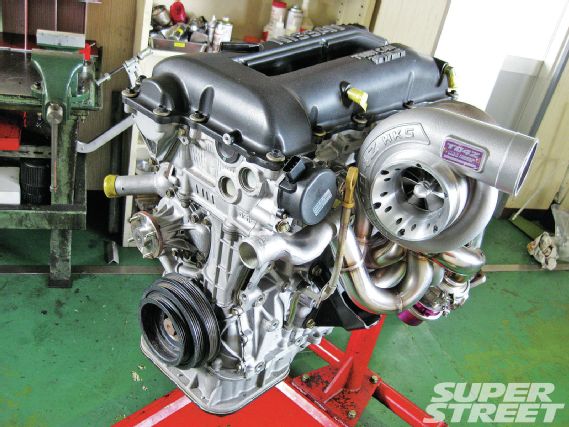 | Building Power With Nissan’s Most Popular Engines - Tech
| Building Power With Nissan’s Most Popular Engines - Tech
SR20DET
The SR20 may be what started it all for most Nissan enthusiasts. They pull a premium a week before race-wars, and for good reason; It’s one of the few 4-cylinder engines that can reliably make over 350whp with just a turbo upgrade and supporting tuning—and with some block work and a big turbo, the sky’s the limit.
OVERVIEW
The SR20 comes out of the box making anywhere from 190-220whp, depending on the year of engine. If you’re still planning a swap I suggest the S14 SR20DET as the Variable Intake Cam timing spools the turbo faster and makes a good amount more mid-range power than the S13 SR20DET—however, that same VCT cam tends to fail with aggressive cams and usually needs to be locked-out with big cams. So if you’re shooting for under 400whp, the S14 SR is likely the way to go. Above that, it doesn’t really matter.
The SR20’s biggest bottleneck is its stock turbo. Depending on what kind of power you’re aiming to make, a simple turbo upgrade, injectors and ECU tuning may be all you need. Going over 350whp you’ll need to change the head gasket and head studs, and above 400-450whp you’ll need to build the block or else throwing a rod or melting a piston is in your certain future. Large cams require solid lifters to replace the hydraulic ones, and valve springs must be matched with the cams to prevent floating a rocker and destroying it (and sometimes, the rest of your engine)!
There are a ton of aftermarket SR20 parts that are designed to withstand years of die-hard abuse. I would hope you buy quality components, especially when it comes to gear that has moving parts.
ENTRY-LEVEL TUNING
The best value for an SR20 is right around 320whp. That will give you a stupid-fast car, one that is powerful enough to spin tires in 3rd gear, but still reliable with the stock engine. You can get away with this setup with the following components.
• Larger turbo: Garrett, HKS and Tomei make bolt-on turbos that fit the stock manifold for this application, and the following sizes work best: GT2871 0.64 A/R for up to 340whp, GT2871 0.86 A/R for up to 380whp.
• Aftermarket water and oil lines: To feed the turbo, make sure you use a turbo restrictor for the Garrett ball bearing turbo!
• Larger fuel injectors: You can use side-feed injectors and the stock fuel rail and pressure regulator for up to 400whp; the suggested size is 740cc.
• Larger fuel pump: There are drop-in replacements available that will flow enough for 400whp on the factory fuel system.
• Front-mount intercooler: You’ll need a reasonably-sized intercooler to avoid heat soaking, which reduces power, leads to detonation and may cause the engine to grenade.
• Turbo-back exhaust: Turbos hate backpressure. You need to free up the flow from the turbo back to make power and to lower turbo temperature.
• Aftermarket or new OEM coilpacks: The stock coilpacks seem to lose their spark energy over time and I find that we often need to upgrade the coilpacks to avoid ignition breakup on high power SR20’s.
• Spark plugs: One or two step colder spark plugs to avoid detonation at high power.
• Aftermarket clutch: to handle the additional torque—the stock clutch will never make it!
• Engine management: There are various options available, from a larger MAF and fuel controller up to a plug and play standalone. Professional tuning on a dyno will be needed either way.
AGGRESSIVE TUNING
The above will get you a setup that is making 300whp, and although the list may seem long, it’s really not very much to get an additional 50% power over stock! These are additional options that can make more power, but remember above 400whp and things get a lot more expensive:
• Aftermarket exhaust manifold: This will yield a lot more high RPM power, as the stock exhaust manifold starts to become a restriction at higher power/rpm.
• Aftermarket head gasket and head-studs: This is required if you plan on doing any sort of lapping or racing with your SR20 above 300whp.
• Aftermarket cams: Depending on the cams you select you can make a lot more top end power at the expense of mid-range, or just go for a mild boost in power from 3000rpm up. You really need to pick the RPM range where you think you’ll be spending most of your time and tune for that.
• Aftermarket intake manifold: An aftermarket manifold will make a lot more high RPM power, but at the expense of the mid-range.
CRAZY TUNING
The above setup will take care of you up to 380whp or so. Beyond that, the setup changes almost entirely, and then the budget needs to double (or more). There are a few guys running around with stock blocks closer to 500whp, but I don’t recommend anything that close to the edge. I’ve seen stock blocks blow at 420whp from throwing a rod.
If you want that kind of power, you’ll need to do away with the bottom-mount manifold and internally gated turbo, and get an aftermarket top-mount manifold, external gate and much larger turbo. A larger fuel system and dual pumps is required above 400-450whp, and right around there you’ll want to consider building the block with rods and pistons at the bare minimum. We’ve seen head porting make a huge difference with power and spool on these engines, so a good multi-angle valve job and some porting is a good idea.
CONCLUSION
As with anything, value is what counts. At 300-350whp the engine is happy, the turbo is still small enough that it is responsive and fun to drive, and the cost is about $15,000 cheaper than what it would take to go up to 450whp. While the SR20 is certainly an amazing engine, it does demand respect as an over-rev can throw a lifter and damage the motor.
Strengths Weaknesses
- Strong block that can handle well over 350lb-ft of torque stock. Extremely easy to work on.
- Small, lightweight engine that fits in many different chassis.
- Tons of inexpensive aftermarket parts available.
- The SR20’s main weakness is its hydraulic lifter and rocker design. Usually you’re okay below 7,500rpm with a soft-cut rev-limiter. Aggressive rev-limiting and high rpm, or big cams without matched springs cause rockers to break.
- Stock head-gasket above 300whp needs to be replaced.
- Stock gearbox usually fails above 350whp depending on the type of abuse.
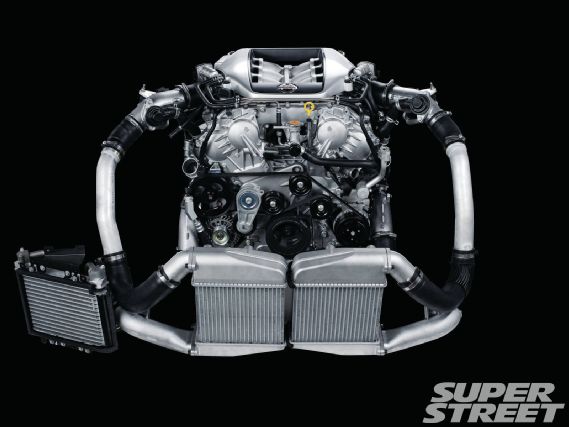 | Building Power With Nissan’s Most Popular Engines - Tech
| Building Power With Nissan’s Most Popular Engines - Tech
VR38DETT
If the VQ35 is close to the perfect engine, then maybe the VR38 is the perfect engine. Unfortunately, they will most likely never become popular swap engines because they are so cost prohibitive both for the engine itself and for aftermarket support.
When we discuss the VR38 in the GT-R, we also need to discuss the transaxle. It seems as though Nissan very specifically designed that transmission for the stock power level of the VR38 and the transaxle rather than the engine is the weak point in the GT-R.
OVERVIEW
The GT-R is already quick from the factory. However, because it’s such a heavy car, no one will argue with a little more power. You can easily unlock another 70whp from the car with simple bolt-ons, but beyond that you need to upgrade both the turbos and the transaxle, so things get a bit more expensive. The GT-R also requires extensive cooling modifications if you plan on using the car for lapping or road racing, specifically for the transaxle.
ENTRY-LEVEL TUNING
500whp is a nice number, and it’s achievable without too much work. The beauty of the GT-R is that its AWD allows the car to be drivable and controllable at that kind of power level. For 500whp you’ll need:
• Exhaust: Turbo-back exhaust (downpipes, mid-pipes and cat-back).
• Intake: Aftermarket high-flow intakes and larger intercooler(s).
• Engine management: An aftermarket, custom-tuned ECU flash.
• Driveline: Transmission service and flash.
AGGRESSIVE TUNING
To step up to 650whp, you’ll need to add the following components:
• Driveline: Transmission service with upgraded clutches (some say the stock clutches with additional clamping would be okay, but we’re assuming you don’t want to risk it).
• Turbo system: Upgraded turbos and wastegate actuators.
• Fuel system: Larger fuel injectors, fuel pumps and upgraded MAF.
CRAZY TUNING
If that’s not enough for you (and I suggest you try it before you claim to need more) you’ll be looking at a big chunk of change to build the internals, but otherwise most of the work would have already been done if you’ve already upgraded the turbos, fuel system and transmission.
CONCLUSION
You can see how the VR38 doesn’t require nearly as many parts that the other engines do to make huge power, and that’s because Nissan has built it so well from the factory. You will be spending a lot of money as all of the aftermarket parts are more expensive and you’re also paying a premium for the expertise of the installer and tuner. Since this engine is still “new” and tuners are spending a lot of time researching and developing parts and systems that work reliably.
Strengths Weaknesses
- Closed deck, strong block that can handle upwards of 750whp Large displacement which spools turbos quickly and has a ton of response.
- The factory setup can make 500whp with just breathing modifications.
- Gearbox is delicate and is known for many different failures including clutches, gears and internal mechanical components.
- High entry price.
- Extremely expensive to modify.
A FINAL WORD
So now you know what it takes to build power with some of Nissan’s most popular engines. Hopefully, it helps you decide on your future build. I always choose value because there are so many other aspects of the car to modify other than just the engine, and balance is what makes a car enjoyable and fun to drive.
What we didn’t mention in this article was the common cooling modifications required among all engines. Obviously, as you increase horsepower, and burn more fuel, you create more heat. If you think you can make all of this power on the stock radiator without doing any cooling modifications—you’re dreaming. It might be fine for a few dyno pulls, but otherwise the car will be essentially useless on the street. Duct the radiator, install an oil cooler, and vent the hood when you’re making big power or else suffer the consequences. Happy tuning!
